There’s nothing quite like walking through a park and along a river, and today I’ll be visiting some of London’s best green spaces!
My route begins at Hyde Park Corner where I’ll visit the Wellington Arch and the Apsley Gate, before heading to Hyde Park and the beautiful lakes at the Serpentine. From there I go past the Serpentine Sackler Gallery and another famous arch, then I’ll end my journey in one of London’s great hidden gems, Italian Gardens! So, boots on, let’s do some walking!

I start at the Wellington Arch, which is located near Hyde Park Corner tube station. Built between 1825 and 1827, the arch was designed by Decimus Burton and has been in its current position since the 1880s. Just like Marble Arch, it was intended to be located at the front of Buckingham Palace.
However, in 1828 with it nearing completion, the cost of the arch had exceeded the budget, and the Treasury declined to pay for the sculpture, as most of their funds had been used to rebuild Buckingham Palace, which itself had run hugely over budget! During this time committees were formed to commemorate two great heroes; Nelson and Wellington. Nelson’s Column in Trafalgar Square was completed, though the Wellington Memorial was less fortunate.
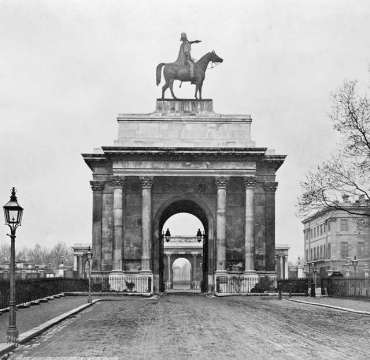
In May 1838 sculptor Matthew Cotes Wyatt erected the largest equestrian statue on the arch. Although this caused controversy as it was disproportionate to the size of the arch itself, and the Government demanded it to be taken down.
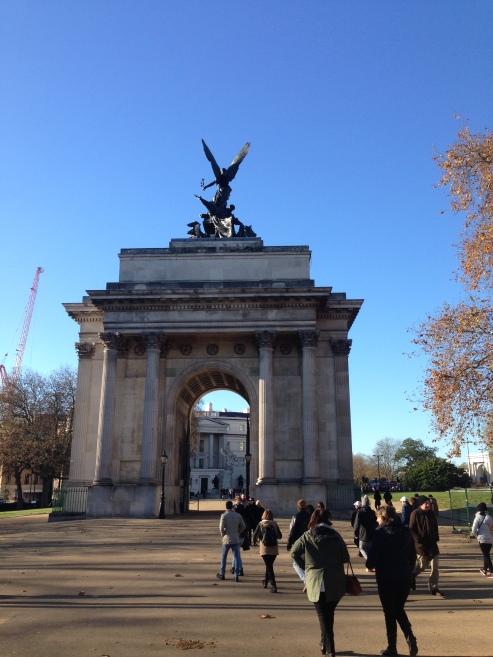
The arch was dismantled in 1883 and rebuilt on its present site in 1885, however, after its relocation the arch still had no sculpture on top of it. In 1891, a quadriga (a four-horse chariot) entitled ‘Triumph’ was sculptured by Adrian Jones, and in 1912 it was erected on top of the arch we see today.
Right next to the Wellington Arch stands the Apsley Gate which is the entrance to Hyde Park. Made from Portland stone, this too was designed by Decimus Burton, and built between 1826 and 1829.

Through the Apsley Gate takes me to Hyde Park! With 350 acres of green space and stunning landscapes, it’s one of London’s eight Royal Parks.

Back in 1536, Henry VII acquired Hyde Park from the monks of Westminster Abbey and would normally use it as a private hunting ground. However, when James I came to the throne, he limited access to it. It wasn’t until 1637 when Charles I made it open to the public that everyone could enjoy its beauty. In 1665, many London citizens camped out in the park to escape the Great Plague.

To mark many significant occasions, Hyde Park became a venue for national celebrations. Notable events included fireworks in 1814 to mark the end of the Napoleonic Wars, the Great Exhibition in 1851, and the Silver Jubilee in 1977 in honour of Queen Elizabeth II’s 25 years on the throne. Since 2007, Hyde Park has hosted the spectacular Winter Wonderland theme park, which includes fairground rides, food markets, shows, and is the perfect way to get into the Christmas spirit!
One of main aspects of Hyde Park that I love is the wonderful Serpentine Lake. This amazing sight was the idea of Queen Caroline, the wife of George II, and was created by damming the Westbourne Stream in 1730. It’s nearly 40 acres with many picturesque views and a cafe nearby where you can sit to see all its beauty. This splendid area was one of the first lakes to be created in England.



It’s such a wonderful feeling just hearing the sound of the birds and the trickling of the water, so very peaceful. The walk along the lake takes you to the Serpentine Bridge which goes over the waters.

When the park was extensively redesigned in the 1820s, John Rennie built the bridge to connect the West Carriage Drive between Hyde Park and Kensington Gardens. When standing on the bridge the view is breathtaking, with Hyde Park on one side, and Kensington Gardens on the other, you feel you’re amongst something special.


Next to the Serpentine Bridge sits the Serpentine Sackler Gallery which was established in 1970 to showcase contemporary art and architecture. In its 47 years this Grade II listed building has presented pioneering exhibitions of 2,263 internationally renowned artists and architects.

From art to another arch! The route from the Serpentine Bridge and Italian Gardens takes you to Henry Moore’s ‘The Arch’. This six-metre high sculpture is made from seven travertine stones which were sourced in Northern Italy. Weighing 37 tonnes it’s positioned on the north bank of the Long Water and was presented by Moore in 1980, two years after his 80th birthday celebrations were held in the Serpentine Gallery.

In 1996 it was dismantled after it was deemed to be structurally unstable. After an 18 month review and discussions between The Royal Parks and The Henry Moore Foundation it was rebuilt and placed in Kensington Gardens during July 2012. It’s great to see it back as it provides a unique view through it of Kensington Gardens, and if you ever want to see rabbits, there are loads near it!
It’s now time to move onto my final stop on today’s walk, Italian Gardens! This Grade II listed water garden is over 150 years old, and is located to the north of Kensington Gardens, near Lancaster Gate. The garden features four main basins and five urns which have designs of a Swan’s breast, woman’s head, ram’s head, dolphin, and oval. Also there is a white marble Tazza Fountain.

The gardens were designed by James Pennethorne, and built in 1860. The inspiration for them came from a similar layout in Osborne House on The Isle of Wight where Prince Regent and the royal family would spend their holidays.
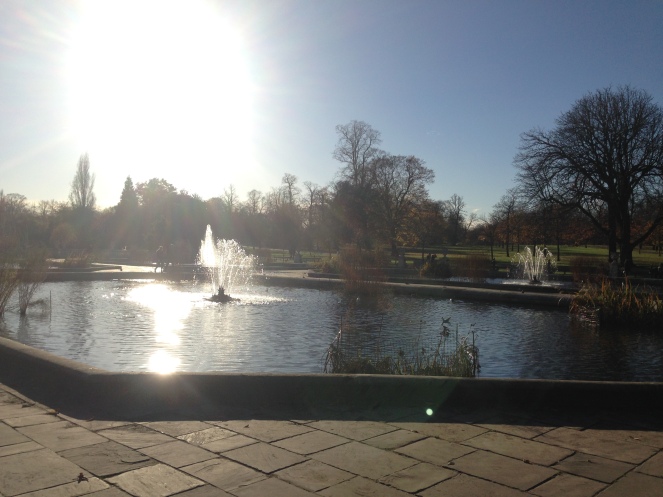
To ensure Italian Gardens kept its wonderful beauty, two notable recent renovations have been undertaken on it, in 1991 and 2011 respectively. In 1991 the vases were re-carved, whilst in 2011 repairs were done including clearing silt from the fountain basins and removing the algae from the Portland stone and marble. The Tazza fountain which overlooks the Long Water also underwent work.

When you sit within these gardens it’s one of the most tranquil places you’ll ever visit, like being in a bubble, not aware of your surroundings. This is a true hidden gem of London, and somewhere you can just stay for ages watching the water flowing from the fountains. You do get a lump in your throat at its beauty.
Now eagle-eyed viewers will notice that the majority of my walks are done when the weather is pretty amazing! There’s two reasons for this. Firstly, recently this winter we’ve had loads of sunny days in London (of course it still does rain…!). And secondly, for me the best way to showcase London’s wonderful sights is to do it when you get clear skies, but rainy day walks can also be good!
But enough talking, I think I’ll stop describing the gardens… as the photos below need no captions, or descriptions 🙂


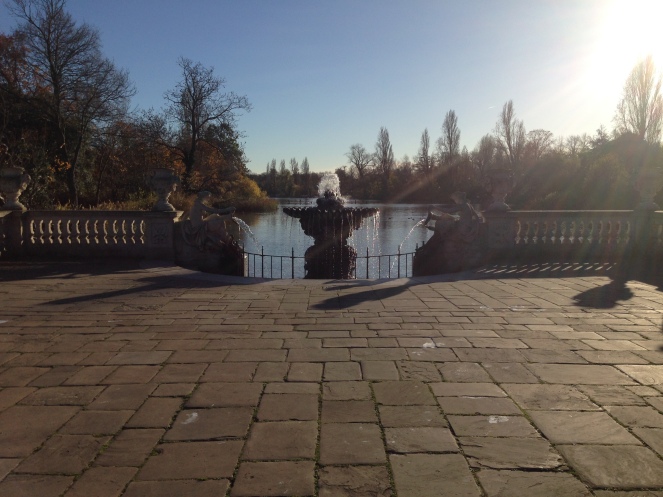

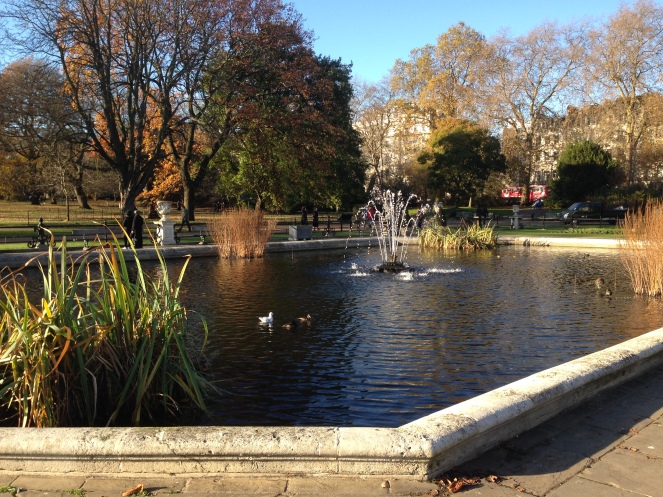
Well, what a stunning way to end today’s walk! It’s been a stroll where we’ve seen some of London’s great arches and green spaces, and I hope you enjoyed reading it as much as I did walking it! Thanks for joining me, and don’t forget to follow me on Twitter, Instagram and Facebook, and to sign up to my blog too
See you next week for another walk!
All photos taken by London Wlogger, unless photo credit given © Copyright 2017
History of the Wellington Arch – English Heritage
History of the Apsley Gate – The Royal Parks
History of Hyde Park – The Royal Parks
Information about the the Serpentine Sackler Gallery – Serpentine Galleries

That was very interesting. I loved the historical stories and they will add to my reading of fictional literature.
LikeLiked by 1 person
Thank you so much! Have an awesome time reading more about it! 😊
LikeLiked by 1 person
I am slightly ashamed to say I don’t think I have heard of these Italian Gardens before, and I worked in London for years. The photos look beautiful and I will try to make a point of seeing the real thing next time I am in town. Thanks for the tip!
LikeLiked by 1 person
Don’t worry, it took me a few trips to Hyde Park and the Serpentine to discover them! My pleasure, you’ll love them! 😊
LikeLiked by 1 person
This is another little belter. I shall drag the missus from the sofa and do this one next week! 🙂
LikeLiked by 1 person
Haha, sounds like a great plan! The weather is amazing at the moment, so perfect for walking adventures! 😊
LikeLiked by 1 person
I used to play hooky and go to that park. I also used to swim in the Serpentine back in the early ’60s. Do they still allow that? the swimming not the truancy 🙂
LikeLiked by 1 person
Haha! I don’t think you’re allowed to anymore, but you can take a pedalo across the lake!
LikeLiked by 1 person
this is a lovely walk; I think the serpentine much underrated by Londoners and the combined park (with the Gardens) one of our best. I included a small piece at the end of my A to Z post on London last April in K is for Kensington and Khelsea (groan) which you might like here.. (cheeky me) https://geofflepard.com/2016/04/13/k-is-for-kensington-and-khelsea-atozchallenge/
LikeLiked by 1 person
The views when you work around it are so incredible, and it’s the perfect way to experience London’s beauty! Haha awesome, I’ll check it out!
LikeLiked by 1 person
You might want to try it yourself given your wide ranging walks… Maybe one day we could join up and share a walk. Be interesting to compare the posts that might follow!!
LikeLiked by 1 person
That sounds great, always love to meet up with fellow walkers! 😊
LikeLiked by 1 person
Brill. Well, my email is glepard@saqnet.co.uk, if you’d like to link up off line we can see if we can find a date to meet.
LikeLiked by 1 person
Wonderful description.
Planning to visit London end of March and your posts will be invaluable.
LikeLiked by 1 person
Awesome, so glad to hear it! Let me know which routes you do 😊
LikeLiked by 1 person
Still in planning stage. Total seven days. London and Scotland.
LikeLiked by 1 person
That’ll be an amazing trip!
LikeLiked by 1 person
Will be our first. No plan to maximize, just take it as it comes.
LikeLiked by 1 person
Oh wow, that’s exciting! You’ll definitely need some great walking journeys then to do 😉
LikeLiked by 1 person
That’s why I enjoyed your timely post🙂
LikeLiked by 1 person
Splendid, glad to hear it 😊
LikeLiked by 1 person
Beautiful walk, and great history
LikeLiked by 1 person
Thanks so much, Joan! Have you been to London much? 😊
LikeLike
Just a few times recently, need to visit again soon.
LikeLiked by 1 person
Excellent, you can use my walks to discover London when you visit! 😉
LikeLiked by 1 person
Thank you
LikeLiked by 1 person
You certainly did choose another lovely day for this walk. We went inside Wellington Arch and it’s a very interesting place to visit. Apsley House, home of the Duke of Wellington, is just over the road and it’s worth visiting too.
LikeLiked by 1 person
There have been so many sunny days here, it seems a shame not to make the most of them! Awesome, there are so many great sights all in the same proximity! 😊
LikeLiked by 1 person
It’s easy to fill in the days that’s for sure. 😊
LikeLiked by 1 person
So very true, there just isn’t enough time to see everything!
LikeLike
What glorious weather for your walk! That is such a beautiful part of London
LikeLiked by 1 person
Sunny days make for the best walks! I couldn’t agree more, walking through parks and along rivers are my favourite 😊
LikeLiked by 1 person
So beautiful!
LikeLiked by 1 person
Isn’t it just!
LikeLiked by 1 person
I’m seriously thinking of taking a weekend trip there!
LikeLiked by 1 person
You should! London is calling 😜
LikeLiked by 1 person
Gorgeous!
LikeLiked by 1 person
You’re very right, one of London’s prettiest areas 😊
LikeLiked by 1 person
I’m from the States and wish we had parks like that near where I live. It looks amazing.
LikeLiked by 1 person
They’re so lovely to walk through and relax in 😊 Hopefully you can visit London soon!
LikeLiked by 1 person
It’s on my bucket list. My husband has been there. Many years ago for business. But I’ve never had the opportunity. But I will.
LikeLiked by 1 person
Excellent, when you come you can both try out my walks 😉
LikeLiked by 1 person
Hi Stu, I admit I found this surprisingly interesting!
I am not a big fan of blogs of this type, and it is many years since I spent time in London, but you managed to catch and hold my interest.
Great stuff..
LikeLiked by 1 person
Thank you so much! Hopefully you can enjoy these walks one day 😊
LikeLike
Reading your post and seeing the pictures makes me long back to London. I have visited many times and I always run in these parks and I feel so at home here and I love to stay in Kensington to be close to the parks
LikeLiked by 1 person
Glad I could bring back some lovely memories 😊 Hopefully you can visit soon to do all my walks!
LikeLiked by 1 person
O yes I will bring my iPad with me so that I will be able to take some of your walks. There are still so much I would like to see as I tend to choose the same places over and over because I love the see them again
LikeLiked by 1 person
Awesome, love your thinking! There’s so much to see in London, but some of the best places are those outside the touristy spots! 😊
LikeLike
I would like to add two things to your lovely post. 1. The Peter Pan statue is quite difficult to find in Kensigton Gardens but I learnt last time that it’s close to The Italian Garden.
2. At the Wellington Arch they have some lovely brochures on the Royal statues and memorials and another one on all the war memorials so you can follow these brochures and find hidden gems all over the place when it’s still daylight and the museums are closed!
LikeLiked by 1 person
Amazing, thanks so much for the extra tips! 😊
LikeLike
Thank you so much it’s your post so I shouldn’t interfere.
LikeLiked by 1 person
I’m always looking for new tips and ideas! 😊
LikeLike
As a Londoner (now living and walking in Brighton), I’m going to enjoy following your walks 🙂
LikeLiked by 1 person
Awesome, I’m glad to hear it! Hopefully you can do them the next time you visit London 😊
LikeLiked by 1 person
I just might 😊
LikeLiked by 1 person
Don’t forget to share your pics! 😊
LikeLiked by 1 person
I did walk through Hyde Park:)
LikeLiked by 1 person
Do love a stroll through this amazing Royal Park 😊
LikeLiked by 1 person
Just wanted to say thanks for the follow on my wee blog, have to get back over to London to get some more images of this fascinating City. Love to find “hidden gems” myself so your blog is very interesting. Keep on strolling, MM 🍀
LikeLiked by 1 person
You’re very welcome, when you next come to London you can try out my walks!
LikeLiked by 1 person
Great post and blog especially as I am returning to London in July.
LikeLiked by 1 person
Perfect, you now have plenty of walks to try out! 😉
LikeLiked by 1 person
This is one of my favourite walks. Thank you for all the historical background
LikeLiked by 1 person
Glad to hear you enjoyed it, Ian! Hope you enjoy all my other walks 🙂
LikeLike